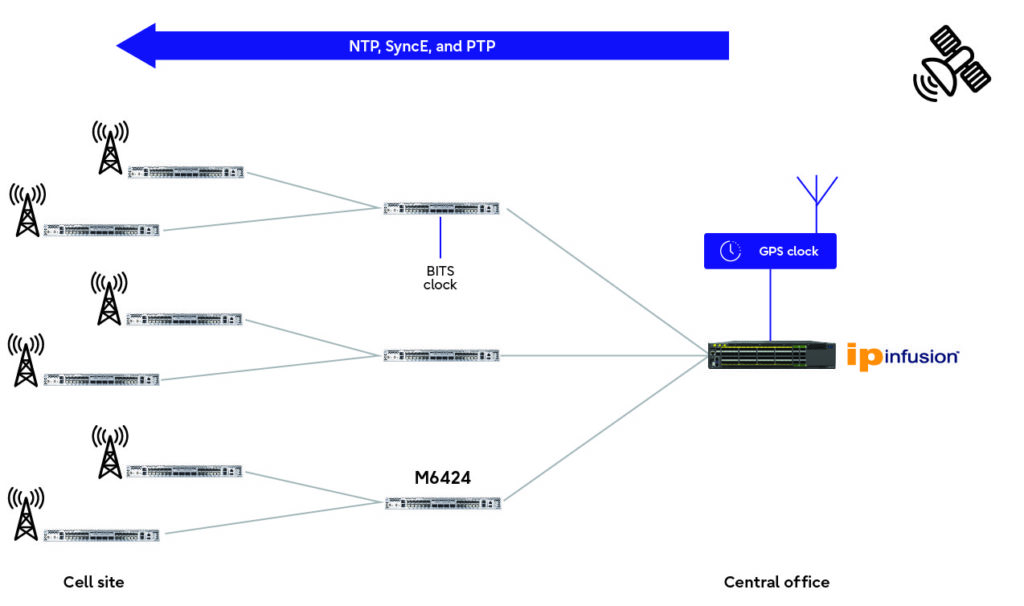A Fujitsu Solution

The first and second blogs in this series focused on the requirements for reliable transport of a synchronization reference signal. The challenge is to ensure latency and jitter budgets are met as timing and synchronization information is distributed across the optical network to support increasingly stringent time sensitive applications such as 5G TDD.
Fujitsu provides an end-to-end solution addressing this challenge. The solution is composed of an edge and a core network offering, and provides a scalable, end-to-end synchronization transport and distribution solution.
Synchronization in the Edge and Access
This part of the network is increasingly packet based, serving residential and business customers with internet access, private line, and wireless services.
Synchronization reference signal processing and support for the PTP/IEEE 1588 timing protocol is now an integral part of new carrier-class Ethernet switches and routers. Fujitsu’s edge product offering is depicted below.

This architecture is based on two product families: the flexiHaul M6424 Time-Sensitive Networking (TSN) Switch and the IP Infusion switching/routing portfolio. These devices provide a complete edge transport solution supporting the following capabilities:
- NTP (Network Time Protocol), SyncE (Synchronous Ethernet) and PTP (Precision Time Protocol) synchronization protocols
- Coaxial interface for GPS-based reference signal
- Synchronization reference signal distribution
- Synchronization reference priority list for redundancy
- Synchronization Status Messaging support for timing loop avoidance
This reference signal distribution solution is integrated within these products and in most cases, no other external synchronization equipment is required other than GPS clocks (or equivalent). These products are compliant to the most stringent PTP/IEEE 1588 requirements by dedicating Ethernet ports as timing ports and assigning them with the highest traffic priority through the switch fabric.

flexiHaul M6424 Time-Sensitive Networking (TSN) Switch


IP Infusion switch/router platforms with OcNOS network operating system
The relatively short transmission distances in the edge typically do not cause major asymmetries between the transmit and receive paths, and hence do not present a problem for PTP timing distribution applications. Also in many cases, service to cell sites utilizes bi-directional transmission over a single fiber so the paths are already symmetric.
Transporting Synchronization Over DWDM
Transmission over traditional OTN or ZR mapped transponders is dependent on the synchronization requirements for the specific application. As mentioned in the previous blog, transponders using OTN or ZR framing can transparently transport Network Time Protocol (NTP) and SyncE messages through the DWDM network. These messages are incoming on the client side of the transponder and are transported to the receiving end without any processing, as depicted below.

Transport of a PTP stream is a lot more demanding and requires a dedicated out of band connection similar to the ROADM’s Optical Service Channel (OSC). Typically, this out-of-band PTP stream is transported as a bi-directional single fiber link over either the transmit or the receive inter-office fiber. The reference architecture to transport PTP messages over a ROADM network is depicted below.

Live traffic occupies the C-band, which spans 1530 – 1565 nm, while the PTP stream occupies out-of-band wavelengths at 1310 nm and 1490 nm. Bi-directional transmission over the single fiber is accomplished using an external fiber splitter/coupler. Other wavelengths such as 1605 nm and 1615 nm can also be used for PTP, if those channels are not used for live traffic.
This approach uses a dedicated optical channel for transporting timing and synchronization information. Furthermore, it avoids the negative impacts of OTN jitter and mapping latency effects on traffic. This preserves the nanosecond level accuracy required for 5G and Time Sensitive Networking applications.
End-to-End integration: The Full Picture
The DWDM core and the packet edge can be integrated into a single end-to-end synchronization reference distribution solution, as represented by the diagram below. This assumes that the full complement of NTP, SyncE and PTP is required at every location in the network. Any application not requiring PTP phase synchronization would simplify the DWDM portion of the network.

In this diagram, the GPS-based grandmaster clock provides PTP streams that distributed directly at the edge of the network. The aggregation router receives this PTP stream and distributes synchronization to other switches and routers further downstream in the access network. The DWDM out-of-band PTP stream can be used as a secondary source in the event that the local reference signal source supplied to the aggregation router is unavailable for any reasons.
Solution Summary
The solution outlined above is designed to take a primary synchronization reference and distribute it over the DWDM core to edge sites, and further distribute it in the access, all the way to 5G cell sites. This architecture provides reliable timing and synchronization throughout the network and meets the stringent latency and jitter budgets required for 5G TDD operation.
More information about the specific products in this solution is included below: